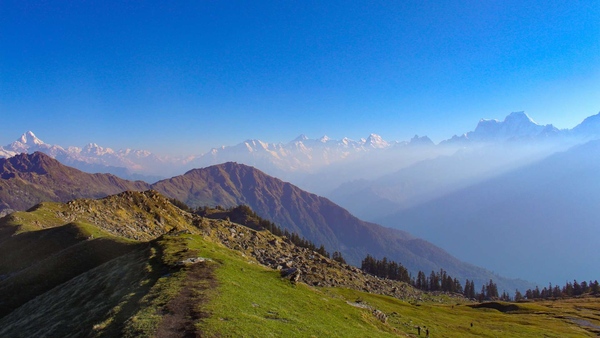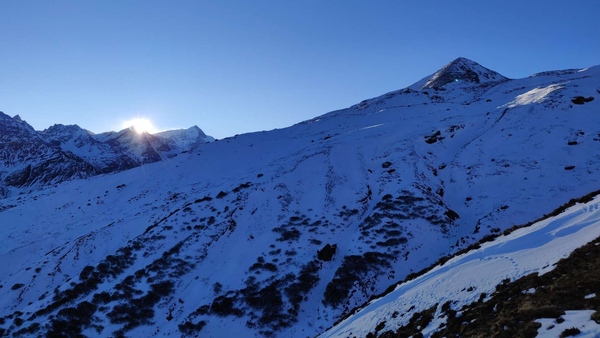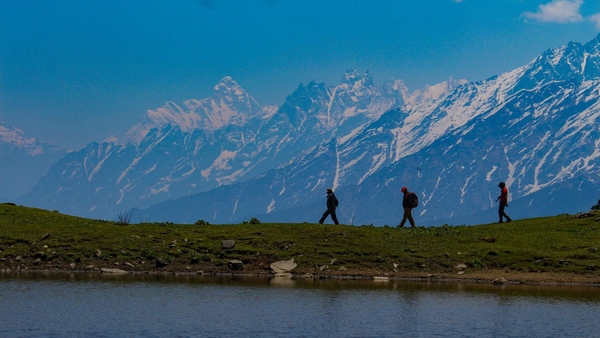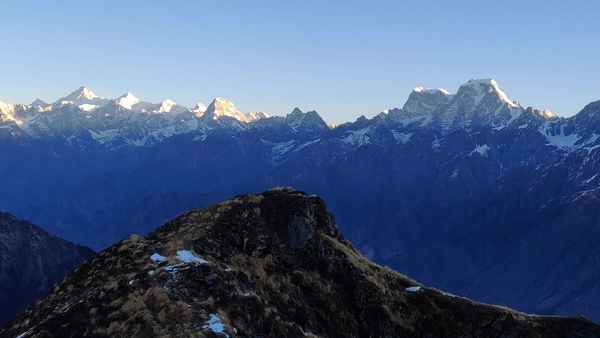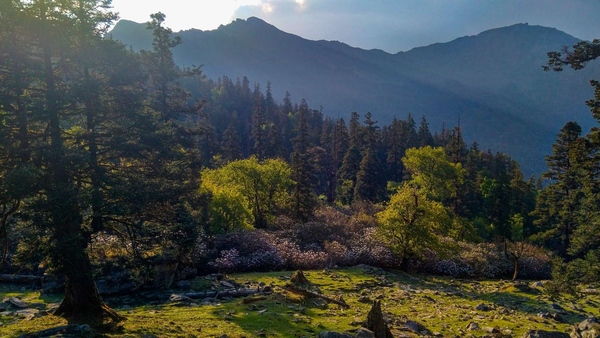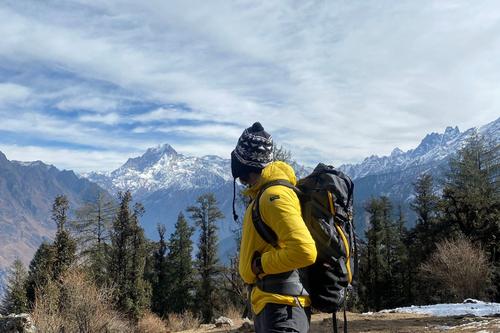Pangarchulla Peak Trek
Hosted by Plan The Unplanned
- Verified Host
- Logout's Trusted
- Traveler's Choice
All About It
- Difficulty - Moderate
- For 12+ years
- Best Season - Spring (Feb, March, April) Summer (May, June, July)
We all lead busy hectic lives, with no time for anything or anyone; sometimes, not even for ourselves. But some “me” time is essential and taking even a week off every now and then might be good for your body and mind.
Now, the definition of taking time off might vary from person to person – some like to laze around at home, others like to soak in some sun and sand.
And then there are the types who will be a perfect fit in the Plan The Unplanned tribe – the ones who like to trek, make new friends and challenge themselves.
If you are in this category, then we have a feeling that Pangarchulla peak winter trek might match your vibe! Taking you to around 15,000 feet, this trek is extremely popular with trekkers and mountaineering enthusiasts. As you watch the sun set and rise above Nanda Devi and almost all the major peaks of the Badrinath Valley, you will feel your soul heal!
Trek Highlights
Although the total trek distance is about 38 kilometres, it will take about 7 days for you to complete the Pangarchulla peak trek. When you take the trip with Plan The Unplanned, all you need to do is get your sense of adventure and your essentials, because we will take care of everything else. But let us say right at the beginning – this is not a trek for beginners!
- We will pick you from Rishikesh and bring you to Joshimath, which is the base camp for the trek
- The drive from Rishikesh to Joshimath will be nothing short of exhilarating
- Get some rest at the homestay, because you will need it the next day
- Your trek will take you from Tugasi village through farms and the side of the Dhauli-Ganga River
- Savour the sights of local villages and farmlands, where flowers, poppies and wheat are cultivated
- The trek won’t be easy, but the marvels of nature all around you will totally make up for it all
- The next amazing experience is your campsite for the night – bang in the middle of a gorgeous forest
- Day 3 is a trek from one camp to another – the hike from Gulling to Khullara offers incredible sights and wonderful memories
- Take a break at night to watch the enchanted skies and wake up for a magical sunrise
- Day 4 starts before daybreak, because we are aiming for the summit by late morning
- Our trek leader will take you via the renowned Lord Curzon Trail and depending on the season, you could have snow-covered fields or lush green carpets
- There are so many summits to spot - Chaukhamba massifs, Mana, Kamet, Abi Gamin, Hathi Parvat, Nanda Ghunti, Trishul, Dronagiri, Changabang, and Kalanka
- We finally start making our way back to Khullara, via Tugasi village and then drive back to Joshimath
More often than not, when we have said our goodbyes at Rishikesh, we already have our tribe making plans for the next trek. If you want to ride that same wave, get in touch with us!
Highlights
Day 1:
‣ Begin your journey with a scenic 280 km drive from Rishikesh to Joshimath
‣ Witness the confluence of Alaknanda at Devprayag and other Prayags en route
‣ Reach Joshimath by evening and rest at the base camp
‣ Overnight stay in guesthouse or homestay
Day 2
‣ Drive from Joshimath to Tugasi, the trek's starting point (14 km, 45 mins)
‣ Trek through charming villages and terraced fields to reach Guling (4 km, 5 hrs)
‣ Witness the first glimpses of snow-covered peaks and thick oak forests
‣ Camp overnight in Guling surrounded by alpine serenity
Day 3
‣ Trek from Guling to Khullara through a trail lined with deodar and rhododendron trees
‣ Ascend steadily for 6 km over 7 hours
‣ Reach Khullara and relax at the peaceful forest campsite
‣ Prepare for the next day's summit attempt
Day 4
‣ Summit day: Trek to Pangarchulla Peak via Khullara (13 km round trip)
‣ Reach a max altitude of 14,700 ft with challenging ridgelines and snow patches
‣ Soak in panoramic views of Nanda Devi, Hathi Parvat, and other majestic peaks
‣ Return to Camp 1 and rest after a strenuous day
Day 5
‣ Trek back from Khullara to Tugasi village (10 km, 6 hrs)
‣ Pass through dense forests and descending trails
‣ Drive back to Joshimath from Tugasi (14 km, 45 mins)
‣ Overnight stay in Joshimath and relax after the adventure
Day 6
‣ Depart from Joshimath and drive back to Rishikesh
‣ Reflect on the summit and your Himalayan experience during the 280 km return drive
*All activities are subject to weather and group decisions. No refunds shall be provided for skipped activities. All timings are an estimate and subject to change
Day 1 - Depart to Joshhimath
Private Vehicle
Homestay
Dinner
A lot of fun at the altitude: Your day of the Pangarchulla Peak expedition kicks off early at 6:00am with us picking you up at Rishikesh ISBT. One can reach Rishikesh easily by regular trains, buses and even taxis through Delhi.
It is one of the most spectacular drives covering a long distance and it winds around the Alankanda River following its course through the rocky core of the Garhwal Himalayas. Another of the best moments of the day is the visit of the Devprayag area which is a holy confluence of the river Bhagirathi and Alaknanda to become the holy Ganga.
Curvy roads, rivers, valleys, mountains and scenery will ensure that your eyes are fixed on the window during the trip. In the evening we arrived in Joshimath, the base camp of the Pangarchulla Trek.
Get in the hotel/guesthouse and enjoy a warm dinner and an overnight stay prepared to start your trek the next day.
Day 2 - Drive from Joshimath to Tugasi (14 Kms, 45 Mins Drive) | Trek to Guling (4 Kms, 5 Hrs)
Trek
Tents
All Meals
We start the journey or the first part of our trek after an early breakfast with a short drive to Joshimath and then proceed to Tugasi village, which was the point of origin of our trekking trail. This is where the hiking trail begins by a hike of 20 minutes, steeply up hill and 45 minutes steep climb uphill. Then, expect another 1-hour of steep hiking until the ground levels at a point where it becomes steep then gentle for the next 1. 5 -2 hours of hiking.
The first thing you come across is a dirt trail that cuts off the road into Tugasi village passing through farmlands with beautiful sights of the Dhauli Ganga River that appears far below. Village trail triggers level tracks followed by ascends and finally there is a rain shelter, which is the first important destination of the day.
The trail turns sharply to the right at the shelter, and goes in the general direction of Lower Tugasi in easy switchbacks. As you pass two water-mills make the sharp turn to the left and continue your ascent up to Upper Tugasi, through the fields of poppies, wheat and a wild-flower.
North of Upper Tugasi the path makes another steep climb with occasional village sections. You will start seeing the Dronagiri Peak that stands majestically in the distance. There is the safe water source after the last settlement to refill bottles.
The last leg to Guling campsite sets at 1.5 to 2 hrs and this will transport you to the shade of oaks and mixed forests. You will have your first glimpses of Hathi and Ghora peaks as you approach the campsite located in the middle of the forest on turning back.
Reach Guling in the late afternoon, take rest in the solitude of the forest and spend a night at the beautiful campsite along the forest.
Day 3 - Trek from Guling to Khullara (6 Kms, 7 Hrs)
Trek
Tents
All Meals
We will have an early morning breakfast in Guling after which we will start climbing to Khullara slowly traversing alpine sceneries along a steeply inclined path. The altitude gain is very little but the path is very scenic and the atmosphere is so calm in the middle of the jungle as we move further into the Garwhal Himalaya.
On the way, we will stop to have our packed lunch with the beauty of large trees and wide ridgeline. During the forest clearings, watch out to get a glimpse of the Mount Dronagiri and Hathi-Ghora peaks.
In the late afternoon we will arrive at the Khullara base camp, where we will then be able to rest in the magnificent high-mountain environment. The rest of the day is free to rest and to sleep and profound thoughts. Once the night comes be ready to be amazed by the sky in the night with stars and not spoiled with city lights.
Follow a hearty dinner and sleep well at Khullara base camp to prepare yourself to the most thrilling segment of the trip awaiting you on the first day of the trek.
Day 4 - Trek to Pangarchulla Summit | Back to Khullara (14 Kms, 12 Hrs)
Trek
Tents
All Meals
Today is the day we have the most difficult as well as most rewarding part of the trek. Our start is early in the morning at 4:00am because we want to summit the Pangarchulla before weather conditions deteriorate after 11:00am.
The route starts by slowly going up on a snowy forest ridge before a 100-meter sharp upward gradient. Anon a broad field of snow greets us, and we are on the way to the upper ridge. Use sunglasses to prevent snow blindness.
We come up on a vantage point with views of the main and subsidiary peaks of Pangarchulla before a 3045-minute climb. Still on the true right of the snow ridge we head down to level snowfields which are frequent advanced base camps. Sceneries of this location are breathtaking-don the sight of the Chaukhamba, Dronagiri, Kamet, Trishul and Nanda Ghunti etc.
The last summit attempt consists of six steep ridges that have to be climbed and descended several times. Appropriate snow equipment, such as crampons, gaiters and ice axes, might be necessary. The final 300-350 m steep climb contains a steep and exposed ridge up, which is technical, particularly in the snow.
The summit is at 15,069 ft, and 360 Himalayan views will definitely make your effort worth it.
Carefully make your way down to the Khullara campsite and this should take about 3-4 hours. Sleep and rest during the summit day at the base camp.
Day 5 - Trek from Khullara to Tugasi (10 Kms, 6 Hrs) | Drive to Joshimath (14 Kms, 45 Mins Drive)
Multiple Modes
Homestay
Breakfast, Dinner
We will have breakfast in Khullara base camp in the early morning after which a briefing session will be held on the last leg of our trek. Once ready, we begin our descent toward Tugasi village.
This walk is forest and open clearings transporting you to a relaxed walk after the challenging uphill climb to the summit. Expect to stop for packed lunch en route.
Having arrived at Tugasi, we get in our vehicle and drive back to Joshimath, thus terminating the trekking process. Let yourself arrive at your allocated homestay, relax, and have a good dinner with the team.
Stay overnight at Joshimath and enjoy the memories about the successful Pangarchulla summit.
Day 6 - Drive back to Rishikesh
Private Vehicle
Stay Not Included
Breakfast
We leave the hotel after breakfast and go by car to Rishikesh. The track passes through the picturesque historical confluences at Karnaprayag of Alaknanda River, Rudraprayag and Devprayag where the sacred river of Bhagirathi and the alaknanda join together to become the sacred Ganga.
It is during this desire that the adventure takes the last trail and it is accompanied by charming views and thoughts about the journey.
Once they have reached Rishikesh, the group will part ways leaving behind millions of memories, magical experiences and friendship made in the embrace of the Himalayas.
Meet your host

Plan The Unplanned
- Verified Host
- Logout's Trusted
- Traveler's Choice
What’s life without adventure? Isn’t the real purpose of life to travel, to experience new places, and witness the sunrise from new mountaintops? This thought is what united Jatin and Tarun over a cup of chai, in spite of being from two unrelated backgrounds (CA and IT). They knew each other since the time Jatin was helping Tarun learn the ways of the wilderness through weekend treks and outings with another traveling group. Their love for traveling and trekking together motivated them to start something of their own. Thus was born “Plan The Unplanned”, where travel goals come true. Under the Companies Act, Plan The Unplanned is incorporated as Unplanned Journeys Private Limited They started their journey on unsteady ground, much like any other company, but they shared an infatuation for travel and adventure with their customers, which amplified their determination, and thus, Plan the Unplanned family keeps getting bigger every day! Just about any travel idea can come alive with Plan The Unplanned…treks, adventure activities like rock climbing, kayaking, rafting, backpacking trips across the country, cultural outings, photo walks; everything that fellow travelers need, to explore the great outdoors together. Well now that the wanderlust has kicked in and you can already see a vacation in your nearest future, here’s what we have to offer!
See Plan The Unplanned's other listingsInclusions
- 2 nights in a hotel or homestay in Joshimath on a triple-sharing basis
- 3 nights in tented accommodation, with three persons per tent
- Surface transfer from Rishikesh to Joshimath and back via Sumo, Bolero, or Tempo Traveler (based on group size)
- All vegetarian meals from Dinner on Day 1 to Breakfast on Day 6
- Camping Equipment Includes tents, sleeping bags, mattresses, dining tent, and toilet tent
- All essential camping equipment, including tents, sleeping bags, mattresses, dining tent, toilet tent, sitting stools, Gaiters, Micro Spikes, and Rope (if required)
- 1:10 guide-to-trekker ratio for a safe and well-managed experience.
- A qualified and experienced trek leader, supported by a trained crew.
- Carefully curated meal plans to ensure variety and nutritional balance across all days.
- A professional team of mountaineering-certified trek leaders, guides, and cooks.
- All essential first aid supplies, including oxygen cylinders and mountain medicines.
- All trekking permits and local permissions arranged in advance.
- The overall experience that you gain during the trek
Important information:
Our treks are conducted in collaboration with trusted local partners registered with ATOAI (Adventure Tour Operators Association of India). These teams bring 20+ years of collective experience and have been working closely with us for over a decade. All on-ground operations, safety measures, and logistics are handled by professional local guides and BMC-certified trek leaders from the base location.
When there are 8 or more bookings from Bangalore, a Plan The Unplanned (PTU) leader will accompany the group to enhance your experience.
Note: To optimise resources, PTU travel groups may be clubbed with fellow trekkers booked through our local partners. We ensure a PTU-exclusive batch when a majority of the seats are reserved by PTU guests.
Exclusions
- Any meals beyond those listed
- Any kind of personal expenses
- Permits and fees for foreign nationals
- Any form of insurance (trekkers are advised to arrange their own)
- Fees and permits applicable for foreign nationals.
- Any expenses arising from unforeseen contingencies such as landslides, curfew, government orders, or natural disasters
- Any expenses related to medical evacuation
- Flight cancellation charges due to delays or any other reason
- Anything not expressly mentioned in the inclusions
Things to carry
✅ Soft copy of your Aadhaar or Voter ID (mandatory for permits)
✅ A sturdy pair of trekking shoes with good grip and ankle support (no sneakers or sports shoes)
✅ 20-litre foldable daypack for summit day essentials
✅ Warm layers, thermals, and weather-appropriate clothing
✅ Lightweight trek pants, t-shirts, and undergarments as per your requirement
✅ Sunglasses, sun cap, and sunscreen for sun protection
✅ 2 pairs of socks + 1 pair of woollen socks and hand gloves
✅ Headlamp or LED torch for night visibility (mandatory)
✅ Trekking pole to support your hike
✅ Poncho or raincoat to stay dry during rain
✅ Spoon, lunch box, and coffee mug (mandatory cutlery)
✅ Personal medical kit with bandages, Dettol, and basic medicines
✅ Toiletries: moisturizer, towel, lip balm, toilet paper, toothbrush, toothpaste, hand sanitizer (no wet wipes)
✅ One 1-litre water bottle to stay hydrated
✅ Extra cash for any meals not covered in your itinerary
✅ Compact raincoat or backpack cover to stay dry
✅ Power bank and charging cable for your phone
✅ Portable chargers for other electronics
✅ Sandals or Floaters for lazing around the campsite
✅ Extra pairs of clothes to change into
✅ Poly bags to pack your wet clothes/travel laundry bag
Policy and more
Here's the cancellation policy for Himalayan Treks/Backpacking Trips/Road Trips
- If you cancel before 30 days - 90% of amount will be refunded
- If you cancel between 20 -30 days - 75% % of amount will be refunded
- If you cancel between 15-19 days - 50% will be refunded
- If you cancel between 7-14 days - 25 % amount will be refunded
- If you cancel between 0- 7 days before the departure date - No amount would be refunded.
Note: For All The Above Refund Cases Transaction Fees/Internet Handling Charges will be dedcuted from the overall amount and balance amount shall be refunded. You can transfer your ticket to anyone so that you could save your hard earned money
For other trips and travels with us, and detailed terms and conditions check the following link : https://www.plantheunplanned.com/refund-cancellation-policy
Frequently Asked Questionss
Q: I have booked the trek when will I get further updates regarding the trek?
A: Well, most of our treks are usually confirmed by Thursday and you would receive a BON VOYAGE mail that would contain details as regards Pickup Points ( Location and Timings ), Outdoor Leader ( Point of Contact ), Do’s and Don’ts. You’ll be added to Whatsapp Group for all the further updates.
Q: Would I be added to a WhatsApp Group once the trek is confirmed?
A: Yes, the Bon Voyage mail would contain a link for Whatsapp Group through which one can join and interact with fellow travellers and outdoor leaders.
Q: I'm a solo traveller, Can I join?
A: The interesting thing about travelling alone is that you get to meet new people from diverse backgrounds, and towards the end, you are no longer strangers. Hence solo travellers are always welcome to join us on our trips.
Read more about solo travelling here and get inspired! https://www.plantheunplanned.com/solo-yet-accompanied/
Q: Is it safe for Women/Girls?
A: Safety and security are our priority at all times. Hence it is safe for women/girls to join us on our treks and travels. Our trek leaders accompany the team at all times, and our campsites are secured and safe for accommodation. We also have female trek leaders who accompany us on most of our treks.
Q: Do I have to carry luggage all the way during trekking?
A: Not at all. You could keep all the extra luggage back at the campsite/homestay and carry only the necessary stuff for the trek (Raincoats, Torchlight, Waterbottle, lunchbox, and your valuable)
Q: Do you have Washrooms during the trek?
A: Well, you are in the mountains and none of our trails has a washroom facility during the trek.
Q: How do I avail discounts?
A: Details for availing discounts are mentioned in the following link, https://www.plantheunplanned.com/membership/
Q: Would I be able to postpone to the future in case I do not attend the trek/trip on the day of departure?
A: We are extremely sorry, you cannot postpone to any future date in case you fail to attend the trek on the mentioned date for any reasons whatsoever (family/health/work emergencies). You can write to us at [email protected] as regards and our team will get in touch with you on the same
Q: How difficult is the Pangarchulla Peak Trek?
A: The hike to Pangarchulla Peak is challenging. A trek is deemed challenging by Indiahikes if it satisfies the following standards. It rises to a height of 15,070 feet. The summit day may take up to 12 hours and involves a 4,000-foot ascent and descent in one day. There are difficult, steep, uneven, and exposed aspects of the summit ascent.
Q: How long is the Pangarchulla Peak Trek?
A: The Pangarchulla Peak trip on the Auli-Pangarchulla Peak-Karchhi path covers a total of 37.5 kilometres. The walk begins at Auli, a village in Uttarakhand's Garhwal area, not far from Joshimath. The journey takes five days (7 days including the travel from Rishikesh and back). You journey for longer than eight hours each day during the three days of the trek, with the exception of the first two, which are brief. You hike for around 12 hours on the summit day. As a result, this makes the route challenging for hikers.
Q: Are there restrooms or toilets on the trek?
A: On the walk, toilet tents will be available to you. Wet wipes are not biodegradable, therefore please do not use them. There won't be a bathroom available during the walk.
Q: What essential documents is needed for the trek?
A: The needed document for the journey is an ID proof (soft copy must be supplied to us in advance; original to be carried).
Q: What seasons are ideal for this trek?
A: The ideal months to hike up Pangarchulla Peak are March–April and October–December.
Q: What level of cellphone connectivity is there on this trek?
A: Joshimath is where you can access the network; beyond that, connection is subpar. Lata can have iffy signals. Beyond this, Auli is the only place you can locate the network.
Q: How to reach the base camp?
A: The final destination on the trek's route, roughly 10 kilometres from Joshimath, is Dhak Village. Small town Joshimath is located 290 kilometres from Haridwar in Uttrakhand. Buses go directly from Dehradun and Haridwar/Rishikesh to Joshimath. Early in the morning, they depart. To go to Joshimath, one may also take a private cab from Haridwar, Rishikesh, or Dehradun.
It is simple to get to Haridwar by car, train, or plane.
By Air:
Jolly Grant airport in Dehradun, located 272 kilometres from Joshimath, is the closest airport. Flights are available from New Delhi to Dehradun.
By Road
There are no direct buses from Delhi to Joshimath. From ISBT Kashmere Gate in Delhi, you may catch overnight UKRTC buses and Volvos to Haridwar. Delhi and Haridwar are separated by 222 kilometres. From Delhi to Haridwar, you may either rent a taxi or an outstation cab.
By Rail:
Joshimath is 187 kilometres from Haridwar, the closest railway station. Numerous trains, including the Dehradun Express and Nanda Devi Express, travel between Delhi and Haridwar. Make your rail reservations at least one month in advance.
More From Plan The Unplanned
[[ event.name ]]
[[event.duration]]
From [[price.price | number:0]]
From [[event.price | number:0]]
Free
[[ batch.startdate|date]] [[batch.soldout ? ' (Soldout)':'']]

